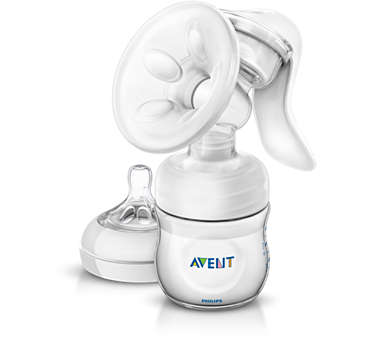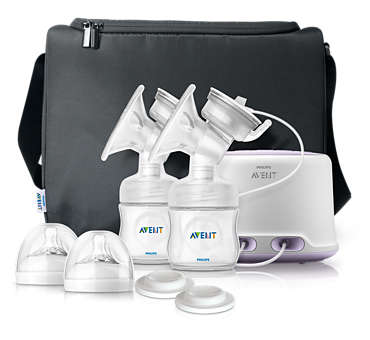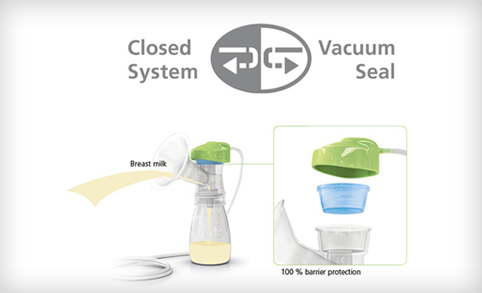| Overall Rating | No Ratings |
Avent Comfort Manual Breast Pump

| Battery Power | Collection | Cushion Insert | Vacuum Dial |
| No | Avent reusable and Via bottles | Yes | No |
| Overall Rating | No Ratings |
Avent Comfort Double Electric Breast Pump

| Battery Power | Collection | Cushion Insert | Vacuum Dial |
| No | Avent reusable and Via bottles | Yes | No |
Open System vs. Closed System – What’s the difference?
 Recently there has been a lot of discussion over whether closed system breast pumps are really better than open system breast pumps. The basic difference between the two types of pump is that closed system pumps have a diaphragm that separates the pump’s tubing from the collection bottle and breast flange.
Recently there has been a lot of discussion over whether closed system breast pumps are really better than open system breast pumps. The basic difference between the two types of pump is that closed system pumps have a diaphragm that separates the pump’s tubing from the collection bottle and breast flange.
A closed system’s diaphragm acts as a barrier, which protects expressed milk from outside air that is being drawn through the pump’s tubes, and it prevents milk from leaking into the tubing. Since this barrier is in place, closed system pumps are considered more hygienic because expressed milk is never exposed to the pump tubing or motor, and the tubing never requires washing or sterilizing.
If you use an open system pump, there is no barrier in between the tubes and milk collection so there is a chance that milk will leak into the pump’s tubing. Most moms see this an more of an inconvenience than anything since you have to then wash, sterilize and air dry the tubes before pumping again. However, some moms say small amounts of milk can get into the pump tubing without you noticing because mold was found in their tubes, but they had not had a milk leak.
If mold is in the tubes then you may have other problems because that means the air going through the pump has been exposed to the mold – the same air that is exposed to the pump motor and your expressed milk. Most pump manufacturers are now switching to a closed system design to prevent these potential problems.
Once you have determined which type of breast pump will be best suited for your pumping needs, you can begin to compare the different models that you are interested in by reading Breast Pump Reviews written by other pumping moms.
How Do the Major Pump Brands Measure Up to One Another?
 Best Pumps – The top rated breast pump brands include Ameda, Ardo Medical and Medela. These pump brands receive the most satisfactory customer reviews across the board.
Best Pumps – The top rated breast pump brands include Ameda, Ardo Medical and Medela. These pump brands receive the most satisfactory customer reviews across the board.
Ameda breast pumps have been a trusted name in hospitals and with lactation consultants for more than 75 years. The Ameda Purely Yours breast pump collection kit is the only FDA approved viral barrier that helps protect breast milk from bacteria, mold, and viruses while pumping.
Ardo Medical is a Swiss Made quality breast pump that is best know for being the quietest breast pump wich is very popular with working moms. Ardo’s pumps are a bit difficult to find but they do work with most insurance companies.
Hygeia offers both hospital and consumer grade electric breast pumps for breastfeeding moms. Their electric pumps are FDA approved to be safe for multiple users and come complete with a total compatibility guarantee.
Medela has been a major manufacturer of breast pumps in the U.S. for more than 30 years. While Medela has built up their reputation with hospitals and lactation consultants, their popularity with consumers has begun to dwindle since they have failed to adopt closed system collection for their pumps.
Philips Avent is one of the most popular infant feeding brands in the country. For over 20 years, Avent has had the most popular manual breast pump, the Isis. The popularity of the Isis led Avent to develop the Isis iQ series of electric breast pumps.
Spectra Baby is a new breast pump company which has a loyal following in the lactation community. Their pumps are know to be very efficient due to their strong suction strength.
Cleaning and Safety Concerns Regarding Breast Pumps
 Daily cleaning – Thoroughly cleaning your breast pump’s washable parts after use is an important step in keeping your baby healthy. All parts that are exposed to breastmilk or your breast should be washed in hot soapy water, rinsed and air-dried after each use.
Daily cleaning – Thoroughly cleaning your breast pump’s washable parts after use is an important step in keeping your baby healthy. All parts that are exposed to breastmilk or your breast should be washed in hot soapy water, rinsed and air-dried after each use.
Sterilizing – Most breast pump manufacturers recommend sterilizing all the washable parts of your breast pump once a day. There are several sterilization methods available including boiling parts on the stove, sterilizing in a dishwasher that reaches 140 degrees, using a microwave sterilizer or an electric sterilizer.
Used breast pumps – Borrowing or buying a used breast pump is not recommended because breast pumps are considered personal hygiene items. Several potential health risks associated with using a previously used breast pump. Some of these risks include the presence of cytomegalovirus (CMV), hepatitis, human immunodeficiency virus (HIV), human T-cell leukemia virus type 1 (HTLV-1) or other viruses on the pump parts that were exposed to the previous mother’s breastmilk.
If you are considering borrowing or buying a used breast pump, you should be aware that not all pump parts can be washed and sterilized. The best way to avoid these potential risks is to only use a new, unused personal breast pump. Although personal use breast pumps are not safe to share, hospital grade rental pumps are approved for multiple users as long as each mother uses her own collection kit.

